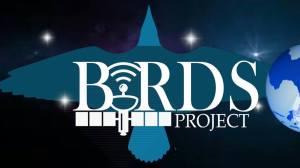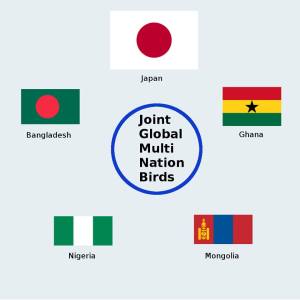The BIRDS constellation, planned to deploy from the ISS in 2017, will consist of four 1U CubeSats (BIRD-B, BIRD-J, BIRD-G and BIRD-M). They are made of the exactly same design including the radio frequencies to be used and will be deployed together.
 The main mission of the constellation is to do experiments on radio communication with a CubeSat constellation via a network of UHF/VHF amateur radio ground stations all over the world.
The main mission of the constellation is to do experiments on radio communication with a CubeSat constellation via a network of UHF/VHF amateur radio ground stations all over the world.
The challenge is to distinguish each satellite from the four satellites transmitting with the same frequency, hand over operation of a satellite from one ground station to another and assemble the satellite data, such as housekeeping telemetry, music and the Earth images, obtained at different ground stations.
Amateur radio enthusiasts are asked to join the network to assist in the data downlink and reconstruction of the patchy satellite data into one meaningful data. Orbit information and operational plan of each satellite will be made available to the amateur radio community in the world. Software to decode the satellite data will be also made available.
The respective amateur ground stations that can successfully decode the telemetry data, music and the Earth images, shall receive a QSL card from the BIRDS team. The data reconstructed by the effort of the amateur ground station network will be made public to share the sense of satisfaction and achievement.
 A particularly interesting mission of BIRDS project is the SNG mission that exchanges music via a digi-singer. It is an outreach-oriented mission. First, music in MIDI format is uploaded from ground. Then the MIDI file is processed on-board using a vocal synthesizer. Finally, the processed music is sent back to Earth using UHF antenna as voice FM data.
A particularly interesting mission of BIRDS project is the SNG mission that exchanges music via a digi-singer. It is an outreach-oriented mission. First, music in MIDI format is uploaded from ground. Then the MIDI file is processed on-board using a vocal synthesizer. Finally, the processed music is sent back to Earth using UHF antenna as voice FM data.
During organized events on space utilization with schools or general public, music could be heard using a common hand-held receiver and hand-made Yagi antenna positioned to track the satellite at each given pass over the region. This has a tremendous effect on awareness of radio communication among school children and general public, especially in the countries participating in the BIRDS project, Japan, Ghana, Mongolia, Nigeria and Bangladesh.
Proposing to use CW, 1k2 AFSK FM, audio FM and 9k6 GMSK downlinks. Planning a JAXA sponsored deployment from the ISS during 2017.
BIRDS project information:
http://birds.ele.kyutech.ac.jp/
http://birds.ele.kyutech.ac.jp/amateur.html
http://birds.ele.kyutech.ac.jp/newsletter.html
https://www.facebook.com/Joint-Global-Multi-Nation-Birds-BIRDS-project-171403156542445/
Download the Paper – IAA-CU-15-01-16 Five-nations CubeSat constellation; An inexpensive test case for learning and capacity building
https://www.researchgate.net/publication/289868265_IAA-CU-15-01-16_Five-nations_CubeSat_constellation_An_inexpensive_test_case_for_learning_and_capaci-_ty_building
The IARU Satellite Frequency Coordination pages are hosted by AMSAT-UK at
http://www.amsat.org.uk/iaru/
![]()
